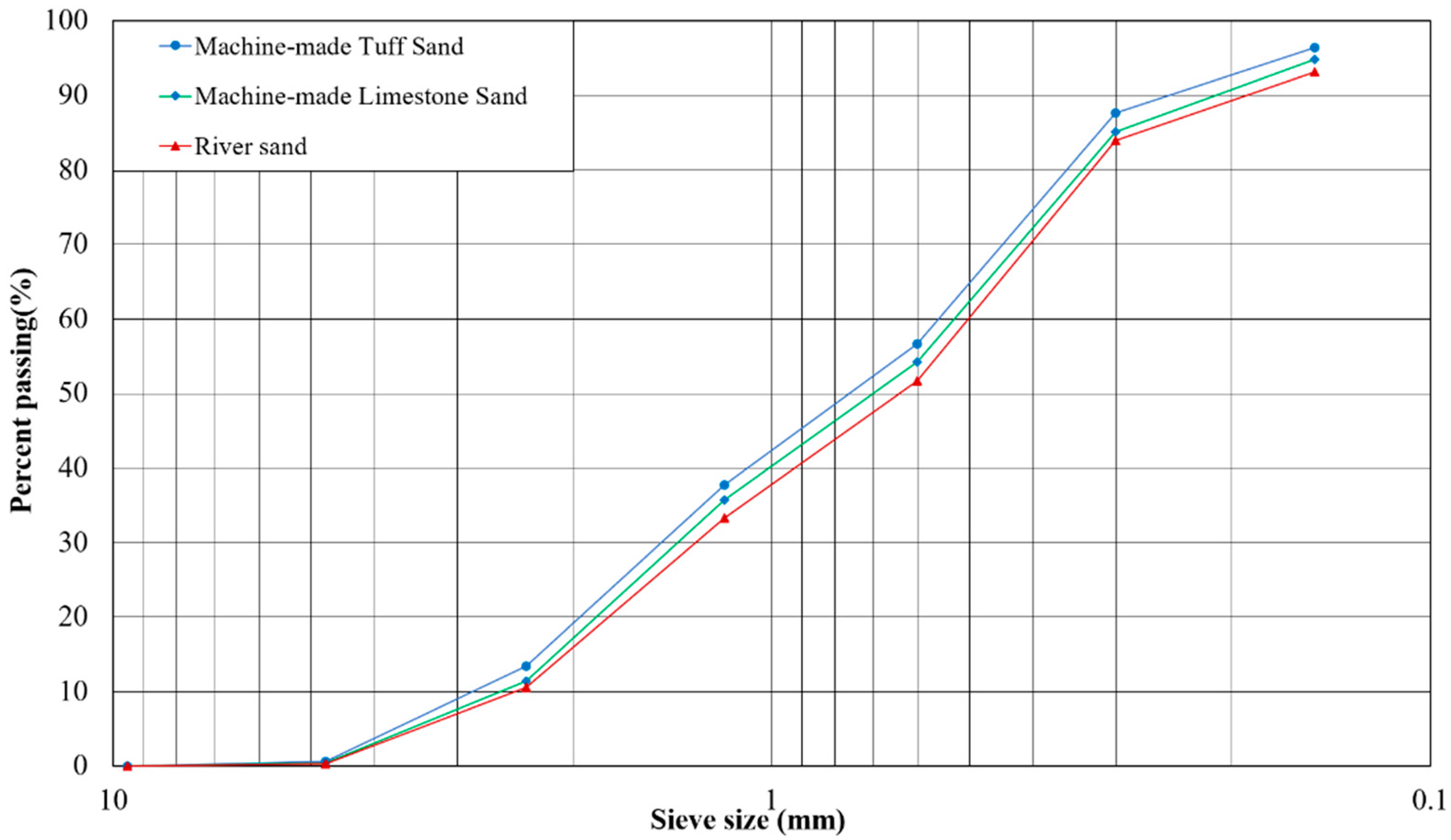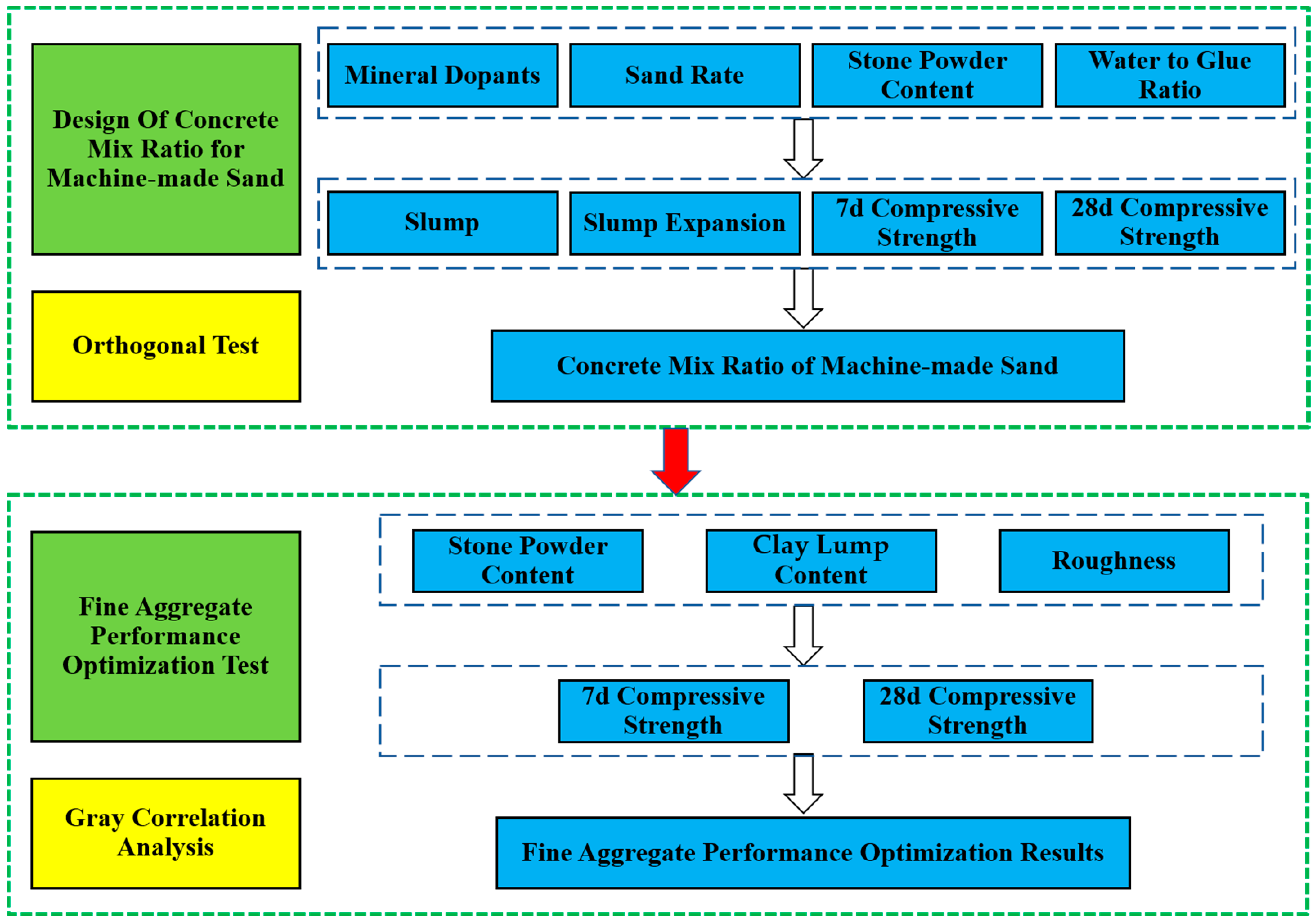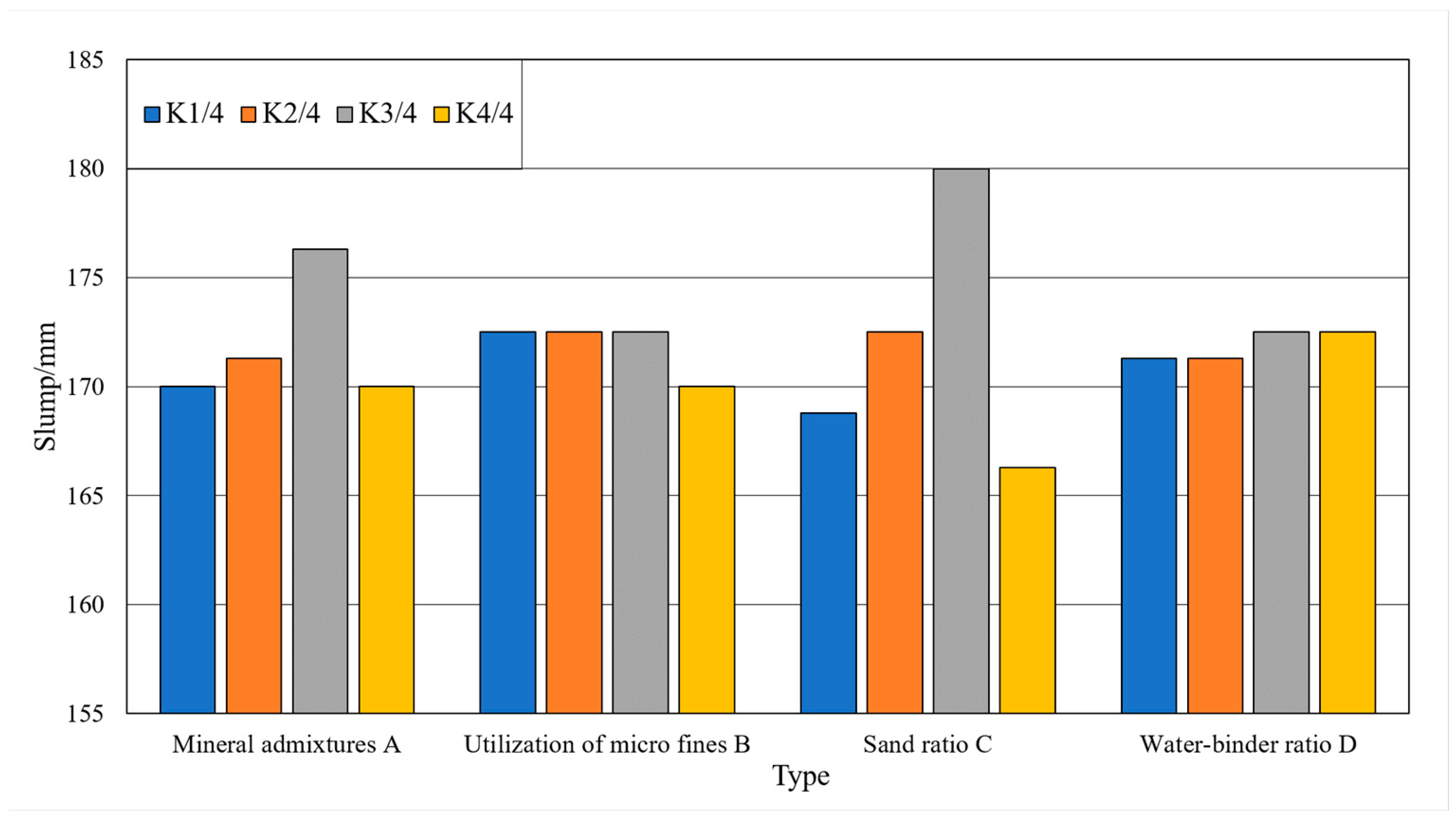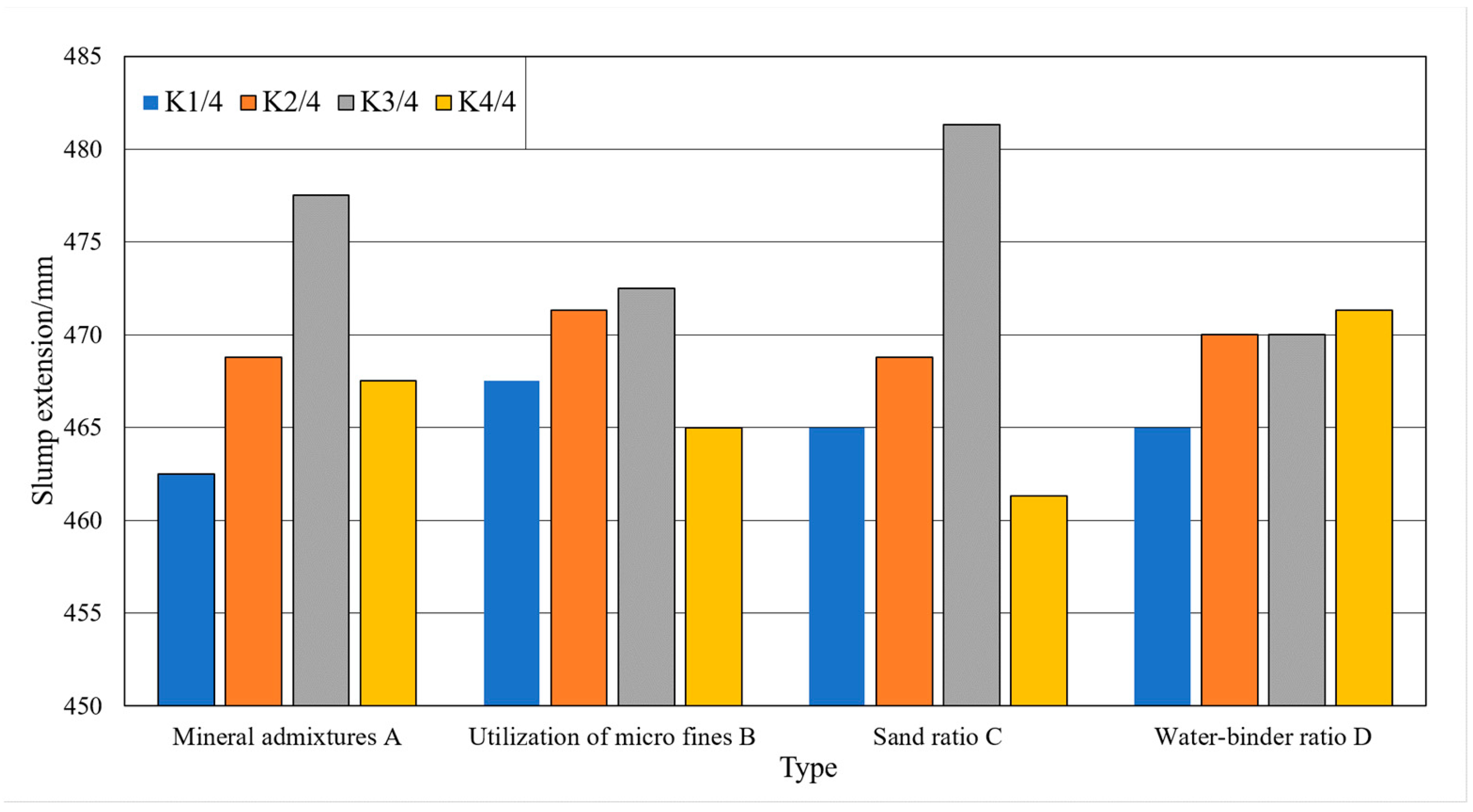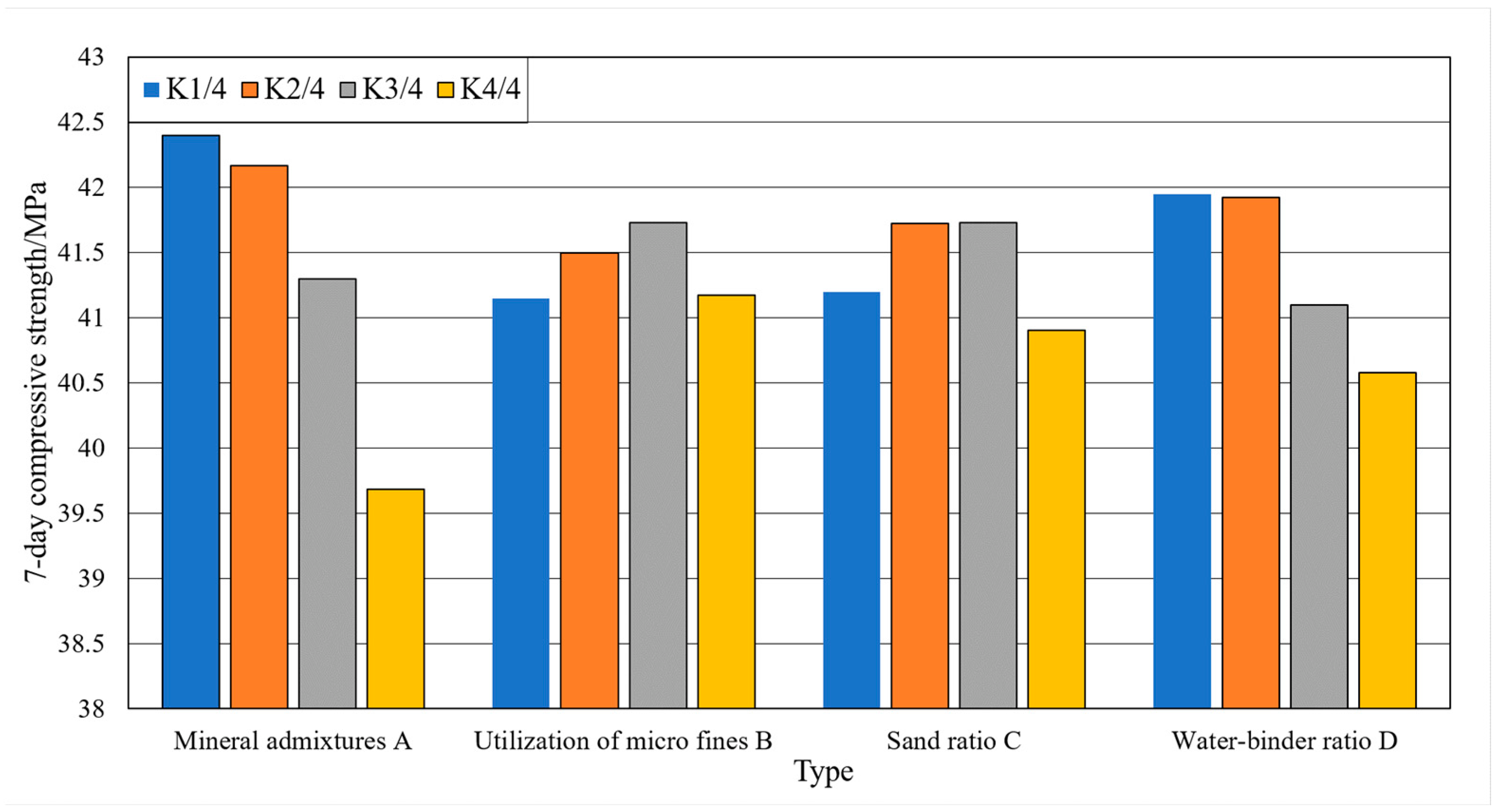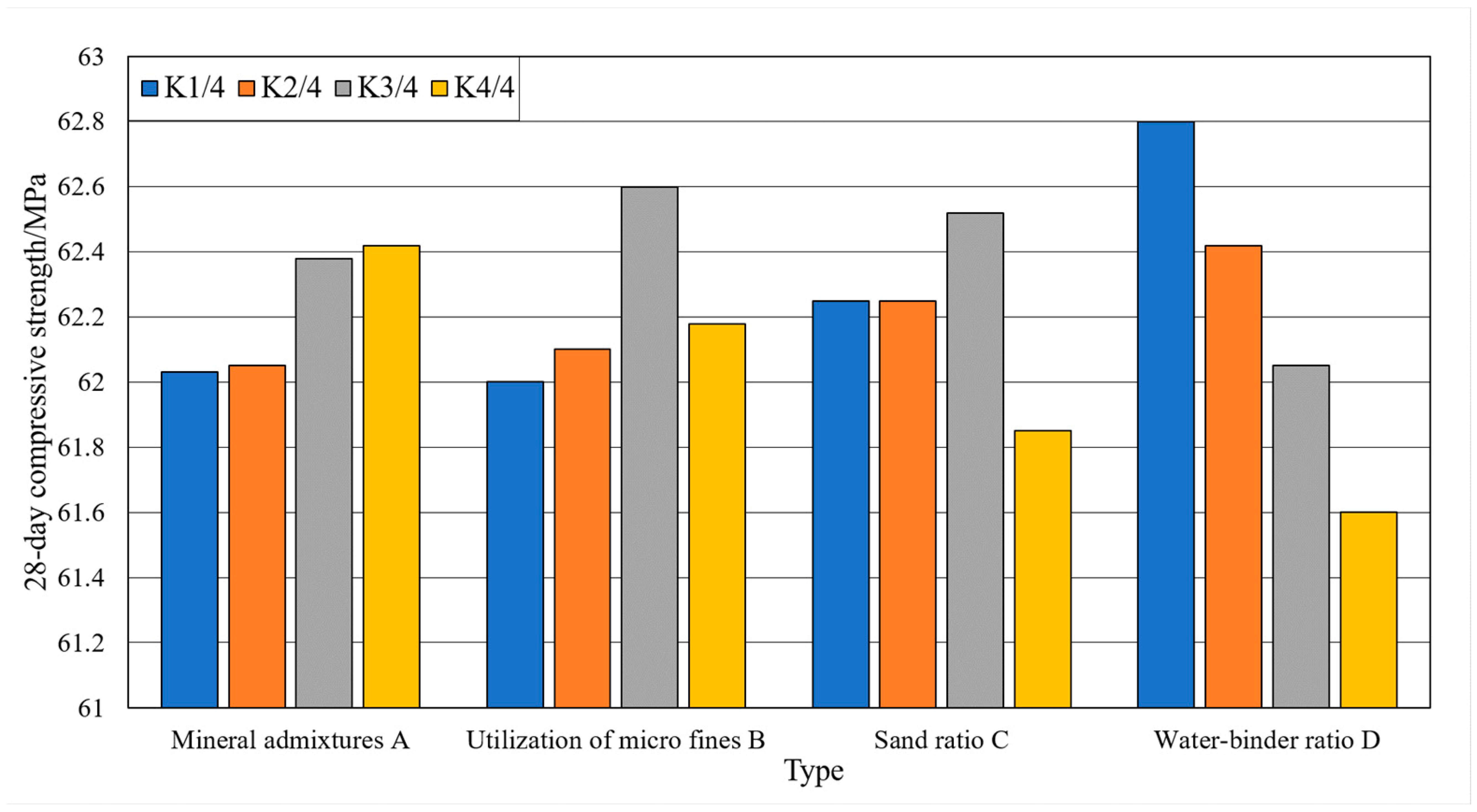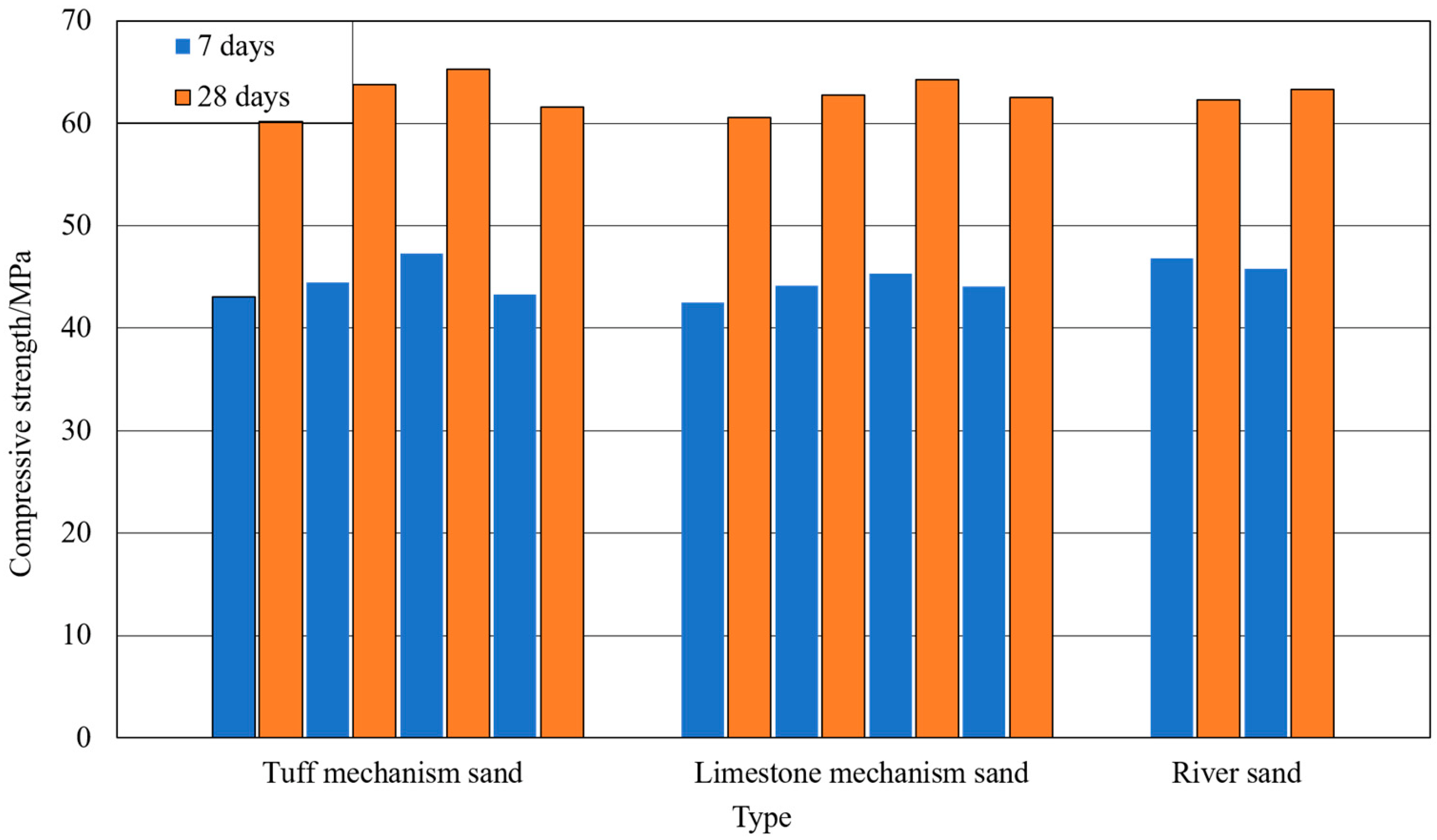3.2. Analysis of Extreme Differences
The orthogonal experimental design software Minitab 20 (State College, PA, USA) was used to perform a polar difference analysis on the experimental results. The extreme difference refers to the difference between the maximum value and the minimum value of the mean value of the test index corresponding to each level in each column. The effect of each level on the test indexes was ranked from largest to smallest by the extreme difference analysis. The results of slump and slump expansion analysis of concrete are shown in
Table 7.
From
Table 7, the influence of each factor on slump and slump expansion is ranked as sand rate > mineral admixture > stone powder content > water–cement ratio. With the increase in sand rate, the slump of fresh concrete tends to increase. There is an optimum ratio of coarse and fine aggregates for fresh concrete. In a certain amount of admixture, as the amount of mineral admixture increases, the concrete slump increases. This is due to the lubricating effect of fine particles of admixtures, so that the fluidity of fresh concrete increases. When the amount of admixture is too large, the amount of water needed to wrap the surface increases, resulting in a decrease in the fluidity of fresh concrete and a decrease in slump. With the increase in stone powder content, the concrete resistance to segregation is enhanced. The specific surface area of stone powder particles is large, and the water requirement for wrapping the powder surface is large. This leads to a decrease in concrete fluidity, but the cohesiveness and water retention of fresh concrete is good. With the increase in the water–cement ratio, the water consumption gradually increases, which to some extent promotes the fluidity and cohesiveness of fresh concrete.
The results of the 7-day and 28-day compressive strength extreme difference analysis of the machine-made sand concrete are shown in
Table 8.
From
Table 8, the degree of influence of each factor on 7-day compressive strength is as follows: mineral admixture > water–cement ratio > sand rate > stone powder content. The degree of influence of each factor on 28-day compressive strength is as follows: water cement ratio > sand rate > stone powder content > mineral admixture. The activity of fly ash in the mineral admixture is very low in the early stage, which does not participate in the reaction and has a weakening effect on the strength of concrete. With the growth of the age of concrete, the mineral admixture activity gradually emerges. However, some studies [
38,
39,
40,
41] pointed out that adding the right amount of mineral admixture can play its filling effect. It reduces the internal voids of concrete and increases the strength of concrete. When the mineral admixture is 20%, the strength of concrete has been significantly enhanced, and further increase the admixture has less effect on the improvement of concrete strength. With the increase in the water–cement ratio, the compressive strengths of concrete showed a gradual decrease. The increase in water consumption of concrete leads to an increase in the probability of excess water forming voids inside the concrete, thus gradually increasing the possibility of reducing the strength of concrete. To ensure the excellent mechanical properties of the machine-made sand concrete, a lower water–cement ratio should be used. The increase in fine aggregate content makes the cement paste more densely filled in the coarse and fine aggregates, which has the effect of enhancing the strength. However, when the sand rate exceeds a certain range, more slurry is required for the bonding surface of the concrete internal aggregate interface with the slurry, making the void rate between fine aggregates not completely filled by the slurry. The particle size of stone powder is between the cementitious material and the machine-made sand. Additionally, it can effectively fill in between the aggregate particles, forming a tightly packed body. However, when the stone powder content exceeds a certain range, it will reduce the fluidity of fresh concrete. Due to its lower activity, it will reduce the strength of concrete.
3.3. Single Factor Analysis
Single factor analysis refers to the situation where the test results vary with a single factor when other factors are constant. The analysis of the effect of single factor on the slump and slump expansion of the machine-made sand concrete is shown in
Figure 4 and
Figure 5. The analysis of the effect of a single factor on the compressive strengths of the machine-made sand concrete is shown in
Figure 6 and
Figure 7.
- (1)
The amount of mineral admixture
As shown in
Figure 4 and
Figure 5, with the gradual increase in mineral admixture, the concrete slump and slump expansion increase first and then decrease. The slump and slump expansion have great values at three levels. As shown in
Figure 6 and
Figure 7, the 7-day compressive strength of concrete gradually decreases with the increase in mineral admixture. The 28-day compressive strength is the opposite, gradually increasing with the increase in mineral admixture. However, the changes in 7-day compressive strength in the four levels are significantly greater than that of 28-day compressive strength. The growth of 28-day compressive strength is not obvious when the mineral admixture is mixed from 20% to 30%.
- (2)
Stone powder content
As shown in
Figure 4 and
Figure 5, the slump of the concrete keeps constant and then decreases with the increase in stone powder content. The slump expansion of concrete shows a trend of increasing and then decreasing. Due to the small particle size of stone powder, it acts as a lubricant in the fresh concrete system. Therefore, when the content of stone powder in the fine aggregate does not exceed a certain range, the fluidity and water retention of concrete has a certain role in promoting. As shown in
Figure 6 and
Figure 7, the compressive strengths show a trend of increasing and then decreasing with increasing stone powder content, with a great value at the third level. After the stone powder content exceeds 10%, the strength value decreases. However, the magnitude of the decrease is small.
- (3)
Sand rate
As shown in
Figure 4 and
Figure 5, the effect of sand rate on slump and slump expansion is similar to that of mineral admixture. With the increase in sand rate, it shows a trend of increasing and then decreasing. There are great values at all three levels. Additionally, the average value of different levels differs greatly. The maximum difference of slump and slump expansion are 13.8 mm and 20.0 mm. As shown in
Figure 6 and
Figure 7, the compressive strengths of concrete reached great values at all three levels. The difference of maximum difference of compressive strength between levels is small.
- (4)
Water–cement ratio
As shown in
Figure 4 and
Figure 5, the slump and slump expansion of concrete show an increasing trend as the water–cement ratio increases. Both of them have maximum values at level 4. As shown in
Figure 6 and
Figure 7, the compressive strengths of concrete change in the opposite pattern to slump and slump expansion. As the water–cement ratio increases, the compressive strengths show a decreasing trend. Unlike factors such as stone powder content, the increase in the water–cement ratio leads to a larger decrease in the 28-day compressive strength of concrete.
In summary, the optimal working performance of the machine-made sand concrete is achieved at a mineral admixture of 20%. Although the corresponding compressive strengths of concrete are not the respective maximum values, they differ from the maximum values by a small margin. The concrete slump and slump expansion are at maximum, and the compressive strengths of concrete are maximum when the sand percentage is 46%. When the stone powder content is 10%, the working performance is better, and it is in the state of imminent deterioration of performance. At this time, the compressive strengths have great values. With the increase in the water–cement ratio, the concrete slump and slump expansion show a gradual increase in trend, which has a certain improvement effect on the work performance. The water–cement ratio has a significant effect on the compressive strengths of concrete, and the strength decreases significantly as the water–cement ratio increases. Therefore, in order to ensure that the concrete has excellent mechanical properties, a lower water–cement ratio should be used as much as possible.
3.6. Grey Correlation Analysis
Grey correlation analysis is based on the similarity of the geometry of the series curves to determine whether they are closely related or not [
42,
43,
44]. Grey correlation analysis is often used in concrete performance research. In exploring the analysis of the effects of stone powder content, clay lump content, roughness and mechanical properties of concrete of machine-made sand, the three subfactors are stone powder content, clay lump content and roughness. Two parent factors are 7-day and 28-day compressive strength of concrete, respectively. Each parent factor has three correlations to the three subfactors. The specific calculation steps are as follows.
- 1.
Data column representation.
Specify the reference data column, which is often noted as , i.e., the parent factor. The first case is denoted as , and the kth case is denoted as . The reference parent series can be expressed as = (…).
- 2.
Initialization process.
Before calculating the correlation coefficient, the series needs to be primed. Each number in the series can be divided in turn by the maximum value in the series to obtain a dimensionless data series for easy comparison.
- 3.
Calculation formula of correlation coefficient and correlation degree.
Referring to the parent sequence
, with
k comparison subsequences
,
, …,
, and the correlation coefficients are calculated as follows.
where
is the resolution, which is used to reduce the error and improve the significance of the difference between the correlation coefficients. The value of 0.5 is taken in the paper.
is the absolute value of the second-degree minimum difference between the
series and the
series at point k.
is the absolute value of the secondary maximum difference between the
series and the
series at point k.
The degree of correlation is calculated by the following equation.
- 4.
Construction of the strengths analysis matrix.
The correlations of the
m parent factors and the corresponding
n child factors are ordered in a row to obtain the correlation matrix
R. The correlation matrix allows the dominance analysis of the parent and child series.
Based on the experimental results in
Table 10, the values of the subseries factors and the parent series factors for tuff sand and limestone sand concrete were primed. The results are presented in
Table 11. The calculations were performed according to the steps in the grey correlation analysis to obtain the machine-made tuff sand correlation matrix
R(1) and the machine-made limestone sand correlation matrix
R(2).
A combined comparison of the machine-made tuff sand concrete correlation matrix R(1) and the limestone sand concrete correlation matrix R(2), and (i = 1, 2) indicate that the correlation between compressive strength and roughness at different ages is the largest. Additionally, the stone powder content has the least correlation. Among the three factors, roughness is the main influencing factor on the strength of the concrete of the machine-made sand. The greater the roughness of the concrete aggregate, the stronger the bond between the aggregates and between the aggregates and the cement paste. Concrete is about less prone to damage when compressed, and thus exhibits higher compressive strength. and (j = 1, 2, 3) indicate that the correlation between the 7-day compressive strength of concrete and roughness, stone powder content, clay lump content is greater compared to the 28-day compressive strength. As the early concrete fly ash has not been fully hydrated, the strength is low, and the enhancing effect of mineral admixture has not been fully developed. Therefore, the early strength of the machine-made sand concrete is more influenced by the roughness and mud lump content. (I = 1, 2) indicate that there is no significant correlation between compressive strengths of concrete and stone powder content. When the stone powder t content does not exceed a certain range (about 10%), the stone powder content has little effect on the compressive strength of concrete. For ordinary concrete, the aggregate and cement paste interface is the high incidence of force damage. Additionally, it is dominated by damage to the bonding surface. The effect of stone powder on the bonding effect of aggregate and cement paste is small. Therefore, the stone powder does not improve the compressive strength of concrete significantly.
The performance of concrete specimens was determined by reducing the stone powder content and clay lump content of the machine-made tuff sand and blending the improved quality fine aggregate, Number NH5. Additionally, we compare it with NH2 batch of machine-made sand under the optimal combination of matching ratio. The results were also compared with the test results of groups 2 and 3. The apparent and bulk densities of the sand in groups 11 and 12 were not significantly different, and the fineness modulus was 2.7. The fine aggregates in groups 11 and 2 were from the same batch, and the performance index values were not significantly different. Other properties of fine aggregates and experimental results are shown in
Table 12. (12
NH2 indicates the 12th group of experiments, using NH2 batch of fine aggregates, others as well.)
From the test results, it can be seen that the compressive strengths of the concrete tested in group 12 are greater than the corresponding values in group 11. The index value of fine aggregate roughness in group 12 is greater than that in group 11 and slightly less than that in group 3. In addition, the difference between the compressive strength values of concrete in group 12 and group 3 is small. The experimental results are consistent with the findings of the study.
